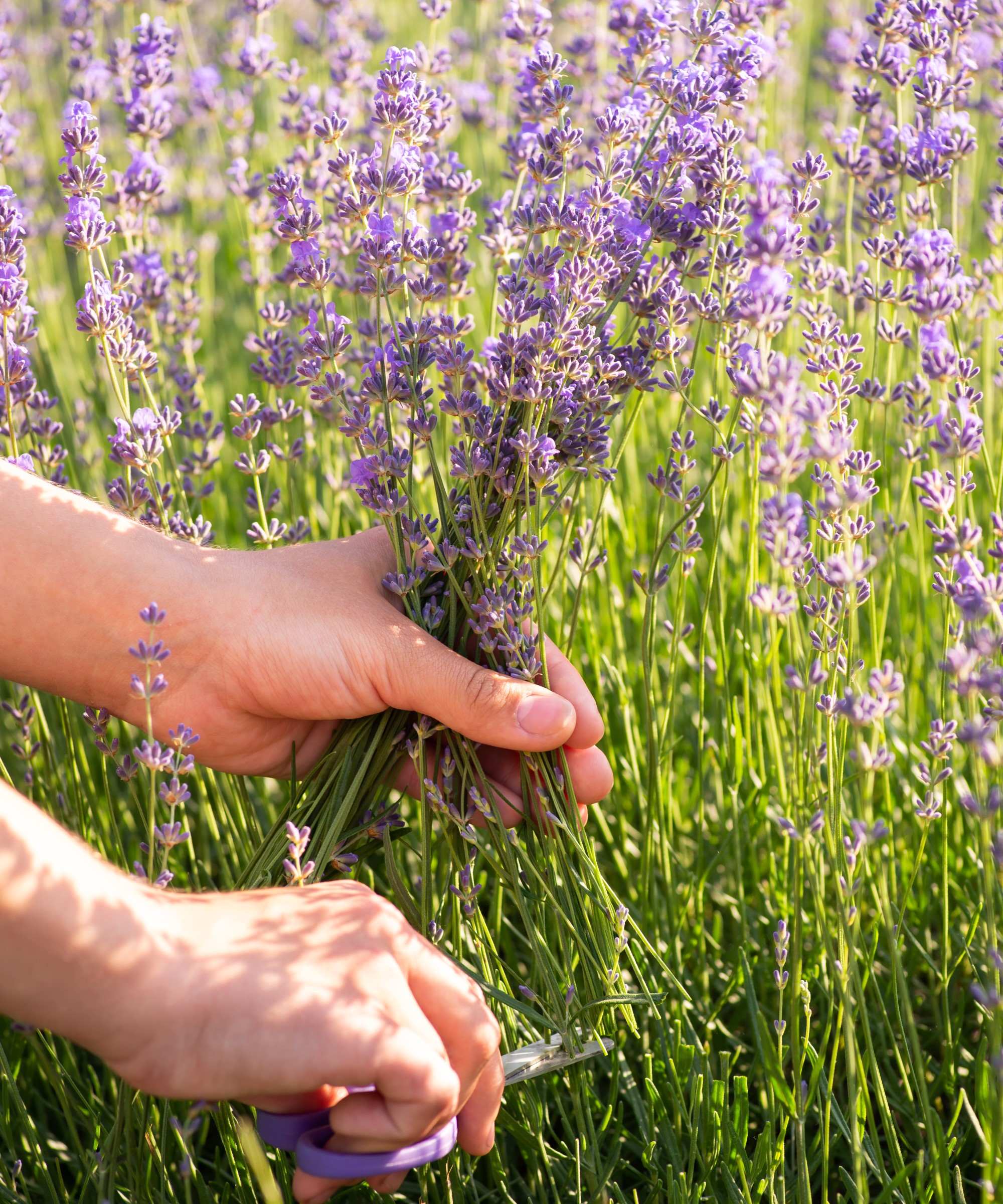Should you deadhead lavender? Expert tips on getting more flowers by removing old blooms
There are so many uses for lavender flowers, so why not maximize your potential harvest by deadheading


Deadheading lavender is a task that is not always seen as essential, but it does offer great benefits. It can prompt a second flush of flowers in some lavender varieties, keep the shrub looking neat and compact, and be part of helping ensure a great display of blooms year-on-year.
I worked at Hidcote Manor Garden in the UK during the early years of my professional gardening career. As well as being a world famous arts-and-crafts garden, it is also a name synonymous with lavender, in the form of the hugely popular Lavender 'Hidcote'.
Both in gardens I worked in, and in my own at home, I have maintained lavender plants over the years. Whenever you are growing lavender they do need proper care and cutting to stop the shrub from going woody and looking unruly. The simple process of deadheading and regular pruning can help keep your lavender neat and prolific.

Deadheading lavender can promote a second set of flowers
Do you deadhead lavender?
Deadheading is a common gardening task, especially during the summer months, to remove old flower heads that have faded from grace. This helps the plant promote more energy into putting out more flowers, rather than putting it into producing seed.
Lavender tends to bloom in late spring and summer and its flowers are a great way to attract bees, butterflies and other pollinators into a garden. Removing that first flush of flowers after the blooms start to fade can help the low-maintenance shrub flower again before the end of the season.
Lisa Fontanarosa, the co-owner of Jo’s Farms, a lavender flower farm in Albuquerque, New Mexico, says: ‘We encourage everyone to deadhead lavender because it will encourage new growth.
‘The lavender flowers usually start to fade by August so it would be a great time to deadhead and remove the faded blooms if you haven’t harvested them before then. By deadheading them, they will come back into bloom.’
Design expertise in your inbox – from inspiring decorating ideas and beautiful celebrity homes to practical gardening advice and shopping round-ups.
Spanish lavenders are the ones that benefit most from being deadheaded. They are capable of blooming multiple times throughout the season and removing faded flowers will be a big help to that. Lots of varieties of English lavender will also bloom again after being deadheaded, including varieties such as ‘Sharon Roberts’, ‘Blue Cushion’, ‘Buena Vista’, and the aforementioned ‘Hidcote’.
Deadheading lavender also neatens up the whole appearance of the shrub, as well as providing you with a lavender harvest of aromatic stems, that are still highly perfumed even when it looks like they are past their best.
Ruth Hayes, gardening expert for Homes & Gardens, admits: ‘I do like to collect a few handfuls of English lavender stems to dry and store to scent the home, as the perfume lingers even when the flowers start to go over.’

Lisa Fontanarosa is an experienced lavender grower and co-owner of Jo's Farms. Together with husband Joe Ornelas, she owns and operates Jo's Farms, a petite lavender flower farm in Albuquerque, New Mexico, where they grow and cultivate lavender and flowers all done by hand, without pesticides.

Snipped aromatic stems can be displayed in the home
How to deadhead lavender
Deadheading is a simple and enjoyable task that requires only a few garden tools. You need a pair of pruning shears, or hedge shears, and a container to collect your trimmings into. These micro-tip pruning snips on Amazon are ideal for deadheading lavender as they are great for precise and intricate pruning.
Always make sure that shears are clean and sharp when deadheading. Keeping tools sharp always means a clean cut and clean garden tools reduce the risk of diseases being moved from plant-to-plant in the yard.
Deadheading lavender can be done in four simple steps:
- Identify a spent flower bloom at the top of the stem.
- Follow the stem back from the flower until you reach a set of leaves.
- Cut the stem carefully just above the set of leaves.
- Repeat the three steps above for each flower stem.
If you have a lot of lavender being grown as hedging plants, or have lavender planted along the sides of paths in the yard, there is a quicker way to remove the old blooms and also keep the lavender looking in the best condition.
John Negus, gardening expert for Homes & Gardens, recommends: ‘Once flowering has finished, lightly trim over the plants with hedge shears to remove the old flower heads. Then, in early spring next year, cut them back much harder, as hard as you dare but without cutting into the woody stems.
‘Doing these two stages of lavender pruning every year will keep plants as strong and as vigorous as possible, and ensure a good display of flowers each summer.’
Using a pair of hedge shears, such as these on Amazon, can make quick work of trimming lavender bushes and the shock-absorbing bumpers will reduce the impact on your arms and shoulders.
It is important to consider when and how to prune any established lavender plants. Getting the pruning wrong is a common lavender growing mistake that can shorten a plant’s lifespan.

John has been a garden journalist for over 50 years and regularly answers readers' questions in Amateur Gardening magazine, including many about evergreen shrubs. He has also written four books and has delivered many talks over the years on horticulture.
FAQs
Does picking lavender encourage more flowers?
Knowing how to harvest lavender and picking it at the right time is a great way of utilizing lavender and also encouraging more flowers. Picking lavender regularly will encourage the plant to put a lot of its energy into producing new flowers, rather than into producing seed. Picking lavender offers the same benefits to the shrub as deadheading lavender, while ensuring you have a great crop of aromatic lavender for all your needs.
What happens if you don't deadhead lavender?
If you don't deadhead lavender then it doesn't mean any harm will come to the shrub. There may, however, be an extra risk of flopping stems exposing the woody part of the shrub in wintry conditions, while old flower heads can be a breeding ground for fungal diseases. Lisa Fontanarosa does point out one benefit of leaving flowerheads, saying: ‘Did you know that you can leave them in place toward the end of the flowering season as food for seed-eating birds such as goldfinches?’
One of the best reasons to grow lavender is for its versatility, both in the garden and also in its uses. You can grow lavender in pots or in a herb garden, it is not even out of place in a flower bed.
Its stems and flowers can then be used in the kitchen, for its medicinal properties, or in cosmetics. Lavender is even a fantastic dry flower to display in the home. There are so many uses for lavender that it definitely pays to cut stems and deadhead the shrub, simply to get even more flowers to use.

Drew has worked as a writer since 2008 and was also a professional gardener for many years. As a trained horticulturist, he worked in prestigious historic gardens, including Hanbury Hall and the world-famous Hidcote Manor Garden. He also spent time as a specialist kitchen gardener at Soho Farmhouse and Netherby Hall, where he grew vegetables, fruit, herbs, and cut flowers for restaurants. Drew has written for numerous print and online publications and is an allotment holder and garden blogger. He is shortlisted for the Digital Gardening Writer of the Year at the 2025 Garden Media Guild Awards.